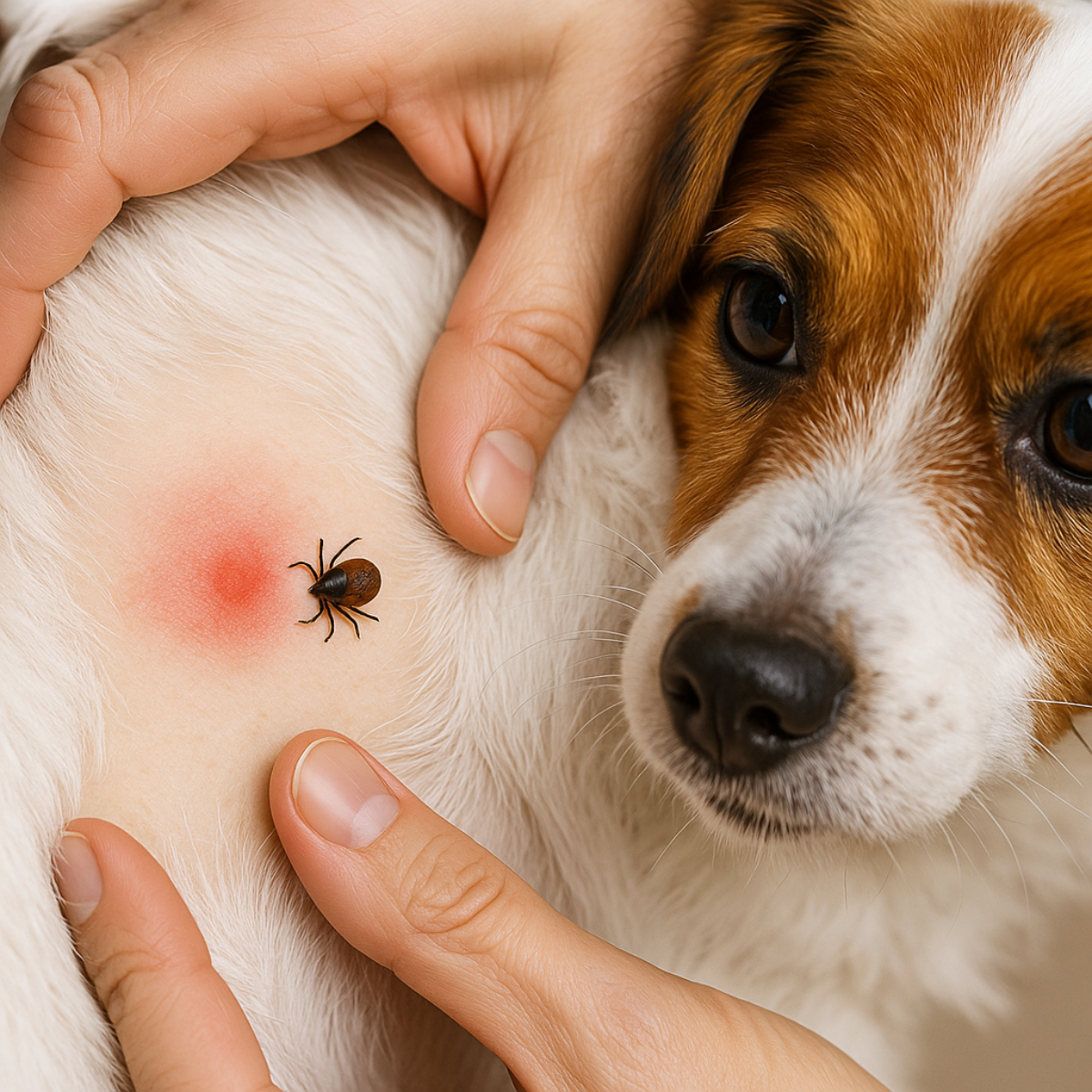
Ticks on dogs - threats, removal and treatment after a bite
Ticks are among the most dangerous external parasites your dog can encounter, whether on a walk in the woods or on a city lawn. Their bites may seem harmless, but in reality, they carry the risk of serious illnesses and complications. In this article, we explain how to effectively remove ticks, what to do if you spot one, and how to protect your dog from this threat.
Species of ticks occurring in Poland
There are several species of ticks in Poland that can pose a threat to both pets and humans:
1. Common tick (Ixodes ricinus)
The most common species. It occurs in wooded areas, meadows, and urban parks. Active from March to November, it is a vector of Lyme disease and tick-borne encephalitis.
2. Meadow tick (Dermacentor reticulatus)
It is increasingly common in Poland, particularly in the eastern and central regions. It transmits diseases such as babesiosis and ehrlichiosis. It often inhabits low vegetation near water bodies.
3. Dog tick (Rhipicephalus sanguineus)
Less common in Poland, it appears in imported cases (e.g., after international travel). It transmits many serious diseases, including babesiosis, anaplasmosis, and ehrlichiosis. It prefers warm environments and can breed in homes.
4. Hedgehog tick (Ixodes hexagonus)
It occurs primarily in the habitat of hedgehogs and small mammals, but can also prey on dogs and cats. It is found in gardens and urban parks. Although it rarely transmits diseases, it can be a vector for babesiosis and Lyme disease.
Identifying the type of tick can help your veterinarian make a more accurate diagnosis and implement appropriate treatment for tick-borne diseases.

Why are ticks dangerous to dogs?
Ticks feed on the blood of mammals and can transmit numerous diseases that threaten the life and health of animals. In Poland, ticks are active from early spring to late autumn, but during milder winters, they can even be active year-round.
🧬 Tick-borne diseases in dogs – types and symptoms:
1. Babesiosis (piroplasmosis)
A parasitic disease caused by protozoa of the genus Babesia , transmitted through the saliva of an infected tick. It attacks red blood cells.
- Symptoms: high fever, apathy, loss of appetite, rapid breathing, dark urine, yellowing of the mucous membranes, sometimes convulsions.
- Consequences: rapid progression of the disease, organ failure, death – if not treated promptly.
2. Lyme disease
A bacterial infectious disease caused by the spirochete Borrelia burgdorferi . Diagnosis is often delayed.
- Symptoms: lameness, joint pain, fever, reluctance to move, depressed mood.
- Effects: chronic arthritis, neurological disorders, kidney and heart damage.
3. Anaplasmosis
Caused by the bacteria Anaplasma phagocytophilum or Anaplasma platys . It affects the circulatory and immune systems.
- Symptoms: fever, weakness, swollen lymph nodes, muscle and joint pain, bleeding gums, bruising.
- Effects: thrombocytopenia (thrombocytopenia), chronic infections, weakened immunity.
4. Ehrlichiosis
A bacterial disease caused by Ehrlichia canis . It often occurs concurrently with other tick-borne infections.
- Symptoms: fever, enlargement of the spleen, liver and lymph nodes, weight loss, nosebleeds, anemia.
- Effects: chronic form may lead to hematological and immunological disorders.
How to recognize a tick bite?
Ticks are most commonly found around the ears, neck, groin, abdomen, and between the toes. Symptoms include:
- a visible tick embedded in the skin,
- swelling or redness,
- scratching a given place,
- lethargy or fever a few days after the bite.

How to remove a tick from a dog – step by step
What do you need?
- tweezers or lasso,
- disposable gloves,
- disinfectant,
- tick container.
Instruction:
- Put on your gloves.
- Grab the tick close to the skin – do not squeeze the abdomen.
- Gently twist or pull out the tick.
- Disinfect the wound.
- Observe the dog for a few days.
Do not use butter, alcohol or fire.

What to do after removing a tick?
- Observe the dog for 5–7 days,
- pay attention to: apathy, loss of appetite, change in urine color,
- contact your veterinarian if you notice any disturbing symptoms.
What to do if a tick transfers to a human?
- Remove the tick as soon as possible.
- Disinfect the area.
- Record the date and location of the bite.
- Follow yourself for 30 days.
- In case of redness, fever, pain – go to the doctor.
Diseases:
- Lyme disease: erythema, muscle and joint pain,
- TBE: flu-like symptoms, neurological symptoms,
- Anaplasmosis: fever, chills, headaches.
How to protect your dog from ticks?
- Collars (Foresto, Beaphar, Scalibor),
- spot-on drops,
- oral tablets,
- natural oils.
FAQ – Frequently Asked Questions
How to protect your home from ticks? Vacuum your home regularly, especially dog beds and resting areas. Disinfect bedding and blankets. Check your dog, as well as your clothes and shoes, after walks—ticks can get inside your home.
Do all ticks carry disease? No – but any tick can.
Can I remove a tick myself? Yes, if you have the right tool and know how.
The tick head remains – what now? Go to the vet.
What are the first symptoms of illness? Apathy, fever, and changes in urine in dogs; erythema and joint pain in humans.
Do natural remedies work? They are less effective – best combined with veterinary products.
Are ticks only present in spring and summer? No – they are active even in winter.
How long can it take from the bite to symptoms? From a few days to a few weeks.
Reliable sources of information about ticks
To deepen your knowledge about ticks, tick-borne diseases and prevention methods, it is worth familiarizing yourself with the materials of scientific and health institutions:
- Chief Sanitary Inspectorate – ticks and prevention
- World Health Organization (WHO) – vector-borne diseases
- National Institute of Public Health PZH – tick-borne diseases
A bite can have serious health consequences. Therefore:
- check your dog's coat,
- react quickly,
- consult your veterinarian.
Prevention saves health and lives.
You can read more about tick-borne diseases in animals on the American Veterinary Medical Association website.
-
CDC – How to Remove Ticks (Official Guide)
👉 https://www.cdc.gov/ticks/removing_a_tick.html
✅ US government website (Centers for Disease Control and Prevention) -
European Scientific Counsel Companion Animal Parasites (ESCCAP) – Ticks in animals
👉 https://www.esccap.org/uploads/docs/fgp5z2t3_0775_ESCCAP_Guideline_GL3_V3_June2022.pdf
✅ Official guidelines from European experts -
Companion Animal Parasite Council (CAPC) – Recommendations for Ticks in Dogs and Cats
👉 https://capcvet.org/guidelines/ticks/
✅ An organization specializing in parasitic diseases of animals -
Merck Veterinary Manual – Babesiosis in Dogs
👉 https://www.merckvetmanual.com/dog-owners/blood-disorders-of-dogs/babesiosis-in-dogs
✅ The authoritative textbook of veterinary medicine


![Pierwsza pomoc dla psa – 7 sytuacji, kiedy musisz działać natychmiast! [PORADNIK] - Petto - Premium gear for your dog and cat. European made](http://petto.com.pl/cdn/shop/articles/Pierwsza_pomoc_dla_psa_45f87a51-e6ca-4a42-aaf1-c3bc5e117514.png?v=1745921434&width=1024)

 https://petto.com.pl
https://petto.com.pl